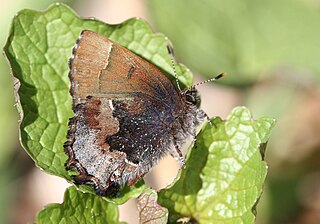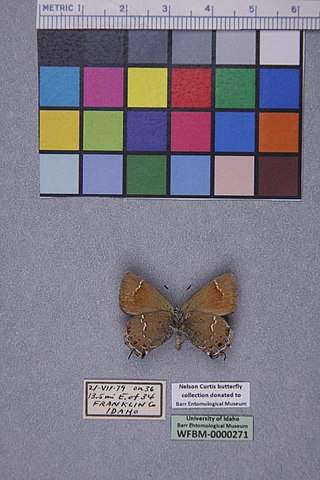
Acmispon glaber is a perennial subshrub in the family Fabaceae. The plant is a pioneer species found in dry areas of California, Arizona, and Mexico. It is commonly found in many areas including chaparral, coastal sand and roadsides at elevations below 1500 m.

The green hairstreak is a small butterfly in the family Lycaenidae.

The gray hairstreak is also called the bean lycaenid or cotton square borer. It is a member of the Lycaenidae family, known as the gossamer-winged butterflies and the second-largest family of butterflies. It is one of the most common hairstreaks in North America, ranging over nearly the entire continent. It also occurs throughout Central America and in northern South America.

The red-banded hairstreak is a butterfly native to the southeastern United States. It feeds on fallen leaves of sumac species and other trees. Its size ranges from 0.9–1.25 inches (23–32 mm). It lives near coastal areas.

The genus Callophrys consists of butterflies in the family Lycaenidae. It is apparently not monophyletic, but which of the taxa currently considered junior synonyms of Callophrys are valid genera remains to be determined.

The Sandia hairstreak is a species of butterfly native to North America. A relatively rare butterfly with a limited range, it was discovered in La Cueva Canyon, Albuquerque, in spring of 1958, by Noel McFarland, then a student at the University of Kansas, and described the following year. The Sandia hairstreak was made one of the state insects of New Mexico in a 2002 bill approved the following year.

Callophrys henrici, the Henry's elfin or woodland elfin, is a North American butterfly in the family Lycaenidae. In Canada it is found from southern Manitoba to southern Nova Scotia. It has two main groups of populations in the United States; the first is found along the Atlantic Coast and uses various hollies (Ilex) as host plants; and the second is found mainly in the north and the Appalachians where they use redbud as a host plant. Henry's elfin is increasing in New England because of an introduced buckthorn it now uses as a host plant. It is listed as a species of special concern in the US state of Connecticut.

Satyrium edwardsii, the Edwards' hairstreak, is a species of butterfly in the family Lycaenidae. It is found in the eastern parts of the United States and in the southern parts of the Canadian provinces from Saskatchewan to Quebec.

Callophrys sheridanii, the Sheridan's hairstreak and Sheridan's green hairstreak, is a butterfly in the family Lycaenidae. It is found in North America along the south coast of British Columbia and parts of Nevada, Arizona, Saskatchewan, North Dakota, and New Mexico. In 2009, this species was adopted as the U.S. state butterfly for Wyoming.

Callophrys augustinus, the brown elfin, is a species of butterfly of the family Lycaenidae, found from Alaska to northern Mexico. One of its subspecies, C. augustinus iroides, is known as the western elfin.

Callophrys spinetorum, the thicket hairstreak, is a butterfly of the family Lycaenidae. It was described by William Chapman Hewitson in 1867. It is found in North America from British Columbia through the Rocky Mountains to New Mexico and Mexico and through California to Baja California. The habitat consists of pinyon-juniper forests, mixed woodlands, and coniferous forests.

Mitoura rosneri, the Rosner's hairstreak, is a butterfly of the family Lycaenidae. It is found in western North America in British Columbia. and Washington state. Subspecies C. r. plicataria is known as Barry's hairstreak.
Callophrys hesseli, or Hessel's hairstreak, is a butterfly of the family Lycaenidae. It ranges from southern Maine south along the Atlantic coastal plain to northern Florida on the Gulf Coast. The species was first described by George W. Rawson and J. Benjamin Ziegler in 1950, in honor of the lepidopterist Sidney Adolphus Hessel. It is listed as endangered in Connecticut by state authorities.
Callophrys viridis, the coastal green hairstreak, is a species of butterfly in the family Lycaenidae. It is endemic to California.

Callophrys nelsoni, or Nelson's hairstreak, is a species of butterfly belonging to the genus Callophrys, wingspan of approximately 1 to 1.5 inches. Like many members of the Lycaenidae family, this butterfly has distinctive rod-like antennae. Callophrys nelsoni are gernually found throughout the west coast of the United States. Although they can be found along the very bottom of Canada's British Columbia and down to Baja California Norte.

Eriogonum elongatum, commonly known as longstem buckwheat or wand buckwheat, is a species of wild buckwheat native to coastal southern and Baja California.













